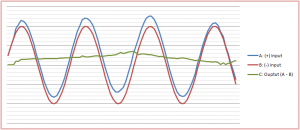Common Mode Rejection Ratio Defined
Editor’s update:
All information in this application note applies equally to model DI-808 data logger with a built-in Web server.
Common mode rejection ratio doesn’t seem at all common. In fact, it sounds rather fancy and complicated. But it’s actually a simple concept. Recall that a common mode voltage is one that occurs simultaneously and in phase on both inputs of a differential amplifier. For a dramatic demonstration of this, please watch the video you’ll find at this link. Channel one’s applied signal in the video has two components:
- A common mode voltage equal to 340-V peak-to-peak (standard US ac line voltage)
- A normal mode voltage equal to the thermocouple signal.

The relationship of common mode, normal mode, and output voltages when applied to a differential amplifier (click to enlarge.)
The nearby graphic helps to reinforce what’s actually going on in the demonstration. Line A in blue is a composite of the applied normal mode (thermocouple) and common mode (line voltage) signals that we applied to the (+) input of the DI-245’s channel 1. You can see that it doesn’t have a consistent amplitude, since it’s a sum of both the signal of interest (thermocouple) and the signal we’d like to reject (line voltage.) Line B in red is pure common mode signal without a normal mode component that’s applied to channel 1’s (-) input. You can see by studying these plots that the common mode component is applied simultaneously and in phase with both amplifier inputs. That prerequisite being met, the differential amplifier can do its job to produce an output that’s the difference between the signals applied to its inputs. The result is shown in green as line C. Of course, the relative signal amplitudes depicted in the plot are way out of proportion for clarity and to avoid complicating the issue with logarithmic scales. The common mode signal is hundreds of volts in the demonstration while the normal model signal is milli-volts with only micro-volt changes.
Common Mode Rejection Ratio Calculation
Now that you understand what signal components are involved and how they relate, it’s time to actually calculate a measure of the amplifier’s ability to reject common mode signals and pass the normal mode signal of interest. The term common mode rejection ratio defines this measure and it’s the ratio of output-to-input signal magnitude. Turning back to the demonstration, we applied a 340-V peak-to-peak common mode signal. Since it’s ac in the shape of a sine wave at 60 Hz we should convert it to its dc equivalent for calculation purposes and use the value 120 Vrms. From the video the narrator noted that the signal on channel one moved the equivalent of about 9 micro-volts with the common mode signal applied. This implies a common mode rejection ratio value of: The above means that for every volt of common mode voltage we apply to a DI-245 input channel, the output will change by only 75 nV. Not bad for such an inexpensive solution as the DI-245! However, it’s kind of clumsy to refer to common mode rejection using scientific notation, so we commonly convert it into a logarithmic value in decibels (dB):
The above means that for every volt of common mode voltage we apply to a DI-245 input channel, the output will change by only 75 nV. Not bad for such an inexpensive solution as the DI-245! However, it’s kind of clumsy to refer to common mode rejection using scientific notation, so we commonly convert it into a logarithmic value in decibels (dB): ![]() So, in this demonstration the DI-245 may be described as providing about 142 dB of common mode rejection. The negative value means that the common mode voltage was reduced by 142 dB.
So, in this demonstration the DI-245 may be described as providing about 142 dB of common mode rejection. The negative value means that the common mode voltage was reduced by 142 dB.
A Word of Caution
Before you apply the demonstration and calculations referenced in this post, be sure that your instrument will tolerate a common mode line voltage. Most won’t and those that fail will do so spectacularly.
More reading:
Model DI-245 Thermocouple, Voltage, Millivolt Data Acquisition System
DI-808 data logger with a built-in Web server
A Graphic Common Mode Voltage Demonstration


 View Cart
View Cart sales@dataq.com
sales@dataq.com 330-668-1444
330-668-1444
3 Comments
Prashant patel
What is the need to calculating the CMRR ?
DaqGuy
CMRR measures a differential amplifier’s ability to reject common mode signals. Higher values are better. In industrial measurements, where common mode signals are common, you need some way to evaluate the suitability of one instrument versus another in terms of measurement quality. Common mode rejection ratio is one such measure.
jweaver
I think what you’ve calculated is common-mode gain, not CMRR. Isn’t CMRR Ad/Ac (differential gain/common mode gain) ?
Also, CMRR (as Ad/Ac) in dB, should be a positive number, and in this case higher is better.